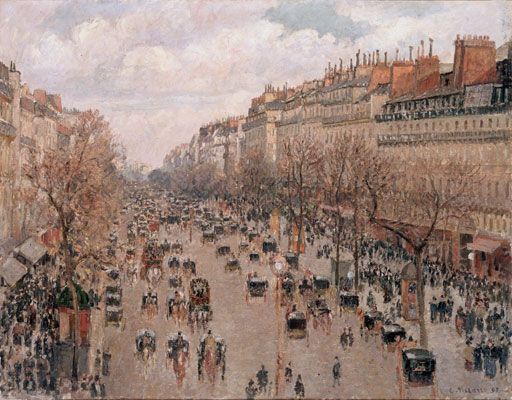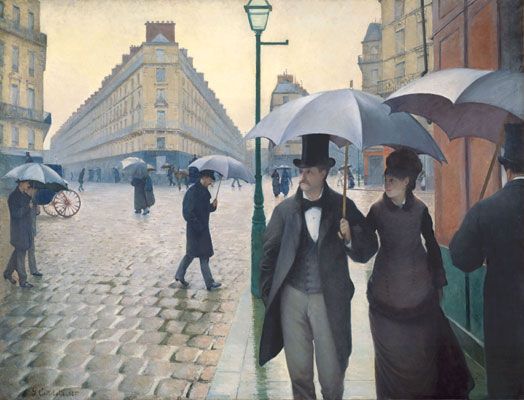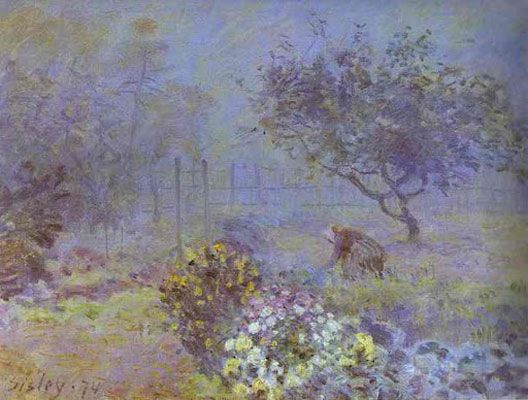Impressionist Cityscapes
Impressionist Cityscapes
Since the movement was deeply embedded within Parisian society, Impressionism was greatly influenced by Baron Georges-Eugène Haussmann’s renovation of the city in the 1860s. The urban project, also referred to as “Haussmannization,” sought to modernize the city and largely centered in the construction of wide boulevards which became hubs of public social activity. This reconstruction of the city also led to the rise of the idea of the flâneur: the idler or lounger who roams the public spaces of the city, observing life while remaining detached from the crowd. In many Impressionist paintings, the detachment of the flâneur is closely associated with modernity and the estrangement of the individual within the metropolis.
These themes of urbanity are depicted in the work of Gustave Caillebotte, a later proponent of the Impressionist movement, who focused on panoramic views of the city and the psychology of its citizens. Although more realistic in style than other Impressionists, Caillebotte’s images, such as Paris, Rainy Day (1877), express the artist’s reaction to the changing nature of society, showing a flâneur in his characteristic black coat and top hat strolling through the open space of the boulevard while gazing at passersby. Other Impressionists depicted the fleeting qualities of movement and light within the metropolis, as in Monet’s Boulevard des Capucines (1873) and Pissarro’s The Boulevard Montmarte, Afternoon (1897). Similarly, these works emphasize the geometrical arrangement of public space through the careful delineation of buildings, trees, and streets. By applying crude brushstrokes and impressionistic streaks of color, the Impressionists evoked the rapid tempo of modern life as a central facet of late-19th-century urban society.

1897 The Boulevard Montmartre, Afternoon
Artist: Camille Pissarro
Pissarro’s Boulevard Montmartre, Afternoon applies the techniques of his earlier plein-air landscapes to the modern city. The work uses broad strokes of paint, carefully applied to the canvas, to represent the fleeting nature of modern life, and the visual impression made by the metropolis. It is one of a series of paintings, painted in Pissarro’s room at the Hotel de Russie overlooking the street, that depict the same scene during different points of the day and different seasons of the year. The series emphasizes the changing effects of natural light upon the urban setting, resulting in a reflection on the passage of time and the transformation of the city.
Pissarro was one of the oldest of the Impressionist group, referred to by Cézanne as “the first Impressionist.” Of mixed Jewish-French-Portuguese heritage, he was born into a merchant family in 1830 on the tiny Caribbean island of St. Thomas. Pissarro’s early paintings depict the sun-drenched beaches and palm trees of his island home, but he attended boarding school in Paris as a child, and moved there permanently in 1855. He became respected amongst the other Impressionist painters both for his artistic skill and for his wisdom, his works characterized by a bright palette, depiction of quiet landscapes, and representation of natural light. Pissarro served as a mentor to many of his younger friends, including Paul Cézanne, and was among the most radical of the Impressionist painters. Indeed, Pissarro saw their decision to form the Société Anonyme des Artistes, Peintres, Sculpteurs, Graveurs in 1874 as a politically significant one, matching his anarchist ideals of self-government.
The only artist to have shown his work at all eight of the Impressionist’s group exhibitions (1874-86), Pissarro also taught a number of Post-Impressionist artists, including Georges Seurat – pioneer of Pointillist techniques – Vincent Van Gogh, and Paul Gauguin. Pissarro’s significance as both an artist and teacher to the development of modern art in the late-nineteenth century cannot be overstated.
Oil on canvas – The State Hermitage Museum, St. Petersburg

1877 Paris Street, Rainy Day
Artist: Gustave Caillebotte
While the work of Gustave Caillebotte adheres to a distinctly Realist aesthetic, it also reflects a concern with modern life that was central to Impressionism. Paris Street, Rainy Day shows this tendency within Caillebotte’s oeuvre. The panoramic view of a rain-drizzled boulevard shows us the newly renovated Parisian metropolis, while the anonymous figures in the background seem to encapsulate the alienation of the individual within the modern city. The painting centers on the apathetic gaze of the male figure in the foreground, who epitomizes the cool detachment of the flâneur, poised in his characteristic black coat and top hat. Like Caillebotte’s other paintings, this work explores the impact of modernity on human psychology, fleeting impressions of the street, and the effect of the changing urban sphere upon society.
Caillebotte was one of the youngest artists associated with Impressionism, born into a rich upper-class family in 1848. His personal wealth meant that he was able to support fellow painters as a patron while also exhibiting alongside them. It is perhaps partly for this reason that he became connected to the group, as, despite his brilliance, there are several points of distinction in his approach. His great attention to the details of the human form, for example, and his relatively close, naturalistic brushwork, is closer in spirit to the tradition of Realism than to Impressionism. Caillebotte’s work is often compared in this respect to that of Degas. Moreover, both artists were heavily influenced by photography, often framing their scenes in such a way that they seemed like snapshots rather than careful arrangements, with buildings and bodies cut in half by the edges of canvases (as above, or in Degas Place de la Concorde [1875]).
In spite of these points, Caillebotte’s works were important in pushing forward the Impressionist emphasis on depicting everyday life. Indeed, despite his background, he was adept at capturing the working and psychological lives of everyday Parisians: not only in scenes of middle-class urban ennui such as Paris Street, but also in scenes of physical labor such as his monumental 1875 painting The Floor Scrapers.
Oil on canvas – The Art Institute of Chicago

1874 Fog, Voisins
Artist: Alfred Sisley
Alfred Sisley’s beautiful pastoral scene showcases a gentle color-palette, evocation of tranquility and peace, and emphasis on the overall quality and atmosphere of a landscape over and above specific details and human forms. The female protagonist of this painting, serenely picking flowers, is almost entirely obscured by the dense fog that eclipses the meadow. As in much of Sisley’s work, the human body seems melded into the natural scene, becoming both an aspect and expression of a wider natural world.
Born in France to English parents, Alfred Sisley met Pissarro and Monet early in the formation of the group, becoming their co-students at the Swiss painter Charles Gleyre’s studio in 1862. Sisley and Monet would go on to become the most dedicated and dazzling proponents of the plein air technique, but their fortunes would take them in different directions. Whereas the middle-class Monet had achieved financial success and fame by the end of his life, the silk-trader’s son Sisley, born into riches, ended his days in relative poverty after his father’s business failed during the Franco-Prussian War of 1870-71. Sisley’s paintings would not yield true financial success until after his death. Nonetheless, he remained prolific throughout his life, and was deeply committed to the ideals of the Impressionist school.
Indeed, the example of Fog, Voisins suggests that Sisley was perhaps the most quintessential Impressionist painter of the whole group. Focusing almost exclusively on representations of light and atmosphere while diminishing the importance of the human form – an approach that many of his peers would grow weary of later in-their careers – Sisley demonstrates his all-consuming preoccupation with representing the moment of perception.
Oil on canvas – Musée d’Orsay, Paris
Source: https://www.theartstory.org




